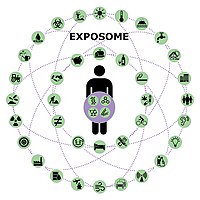
Photo from wikipedia
An accurate estimation of population exposure to particulate matter with an aerodynamic diameter Click to show full abstract
An accurate estimation of population exposure to particulate matter with an aerodynamic diameter <2.5 μm (PM2.5) is crucial to hazard assessment and epidemiology. This study integrated annual data from 1146 in-home air monitors, air quality monitoring network, public applications, and traffic smart cards to determine the pattern of PM2.5 concentrations and activities in different microenvironments (including outdoors, indoors, subways, buses, and cars). By combining massive amounts of signaling data from cell phones, this study applied a spatio-temporally weighted model to improve the estimation of PM2.5 exposure. Using Shanghai as a case study, the annual average indoor PM2.5 concentration was estimated to be 29.3 ± 27.1 μg/m3 (n = 365), with an average infiltration factor of 0.63. The spatio-temporally weighted PM2.5 exposure was estimated to be 32.1 ± 13.9 μg/m3 (n = 365), with indoor PM2.5 contributing the most (85.1%), followed by outdoor (7.6%), bus (3.7%), subway (3.1%), and car (0.5%). However, considering that outdoor PM2.5 makes a significant contribution to indoor PM2.5, outdoor PM2.5 was responsible for most of the exposure in Shanghai. A heatmap of PM2.5 exposure indicated that the inner-city exposure index was significantly higher than that of the outskirts city, which demonstrated that the importance of spatial differences in population exposure estimation.
Journal Title: Environmental pollution
Year Published: 2019
Link to full text (if available)
Share on Social Media: Sign Up to like & get
recommendations!